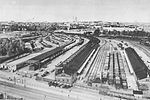Villa Hakasalmi

Villa Hakasalmi (Finnish: Hakasalmen huvila, Swedish: Villa Hagasund), also known as Villa Karamzin, is an architecturally and historically important 19th-century villa located in the Etu-Töölö district of central Helsinki, Finland. The villa is situated in a prominent position on Mannerheimintie, next to Finlandia Hall and opposite the National Museum.Designed by architect Ernst Lohrmann in the Empire style and built in 1844–1846, the villa was originally the summer residence of Senator and State Councillor Carl Johan Walleen. In 1896, Walleen's step-daughter Aurora Karamzin sold the villa to the City of Helsinki, although she was allowed to continue living there until her death six years later.Since 1912, the villa has been occupied by the Helsinki City Museum, as one of its five main exhibition venues.
Excerpt from the Wikipedia article Villa Hakasalmi (License: CC BY-SA 3.0, Authors, Images).Villa Hakasalmi
Mannerheimintie, Helsinki Etu-Töölö (Southern major district)
Geographical coordinates (GPS) Address Website External links Nearby Places Show on map
Geographical coordinates (GPS)
| Latitude | Longitude |
|---|---|
| N 60.174716 ° | E 24.934107 ° |
Address
Hakasalmen huvila
Mannerheimintie 13 B
00100 Helsinki, Etu-Töölö (Southern major district)
Finland
Open on Google Maps









